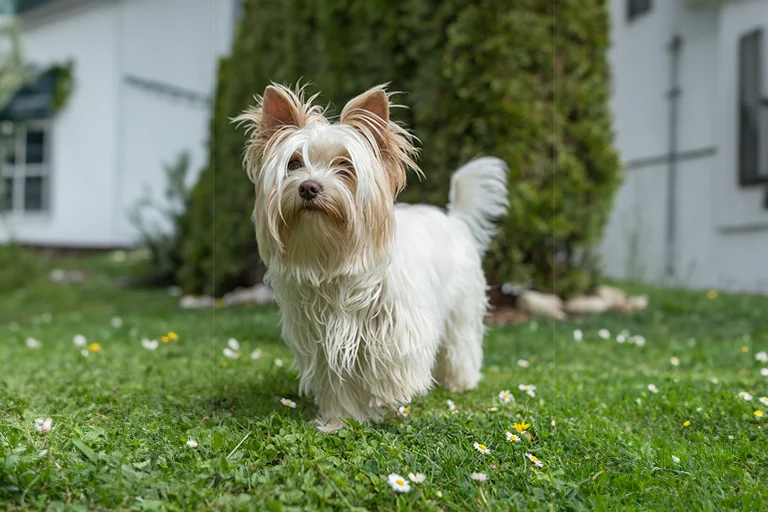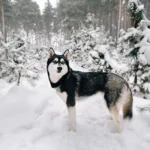Meet the Yorkshire Terrier: a tiny dog with lots of energy and charm. They are originally from England for catching rats.
Fun Facts About Yorkies
- They’re small but brave and full of life.
- Yorkies love being around people and make great lap dogs.
- Their beautiful coats need regular grooming to stay shiny.
Life with a Yorkie
Yorkshire Terriers are perfect for small spaces like apartments. They enjoy indoor play and short walks. They’re also good at keeping watch and will alert you to anything unusual.
This table provides a comprehensive overview of the Yorkshire Terrier breed;
| Category | Detail |
|---|---|
| Breed Name | Yorkshire Terrier |
| Origin | England, 19th century |
| Breed Group | Toy (AKC), Companion (UKC) |
| Size Classification | Small |
| Weight Range | Typically 4-7 lbs (1.8-3.2 kg) |
| Height Range | 7-8 inches (17.5-20 cm) at the withers |
| Life Expectancy | 12-15 years |
| Coat Type | Fine, straight, and silky |
| Coat Colors and Markings | Blue and tan, with the blue ranging from dark steel to a silvery tone |
| Grooming Needs | High; requires regular grooming and haircuts |
| Shedding | Minimal; considered good for allergy sufferers |
| Temperament | Spirited, affectionate, and intelligent |
| Behavioral Tendencies | Can be vocal, enjoys attention, sometimes wary of strangers |
| Social/Behavioral Traits | Good with families, can be assertive with other dogs, enjoys companionship |
| Activity Level | Moderate; enjoys short walks and playtime |
| Trainability | Moderate; can be stubborn but responds well to positive reinforcement |
| Intelligence Level | Intelligent and quick to learn |
| Barking Tendency | High; often barks at unfamiliar sounds or people |
| Health Issues | Dental issues, patellar luxation, hypoglycemia, tracheal collapse |
| Dietary Needs | Small, frequent meals recommended; prone to dental issues so quality food is important |
| Suitability for | Apartment living, families, singles, seniors, first-time dog owners |
| Breed History | Originally bred for catching rats in mills, later became a fashionable companion for nobility |
| Exercise Requirements | Daily walks and play sessions; mental stimulation is also important |
| Space Requirements | Well-suited to apartment living due to small size |
| Sleeping Requirements | Typically 12-14 hours a day, including naps |
| Climate Adaptability | Sensitive to extreme temperatures; prefers moderate climates |
| Travel and Relocation Considerations | Adaptable to travel and new environments, but routine is important |
| Compatibility Scorecard | City Living: 5/5, Families: 4/5, Novice Owners: 4/5, Exercise Enthusiasts: 2/5 |
| Ancestry and Bloodlines | Developed from various terrier breeds including the Clydesdale Terrier and the Skye Terrier |
| Notable Traits | Compact size, elegant bearing, long and luxurious coat |
| Role | Companion dog, show dog |
| Care Requirements | Regular grooming, dental care, and companionship |
| Cost Breakdown | Food: $20-$30/month, Grooming: $40-$60 every 4-6 weeks, Veterinary care: $200-$500/year, Training: $50-$150/course, Insurance: $20-$40/month |
| Training and Socialization | Early socialization and consistent, gentle training are key |
| Time Commitment | Daily interaction, grooming, and exercise are necessary |
| Enrichment Activities | Interactive toys, agility training, social outings |
| Common Training Mistakes | Failing to establish a routine, not addressing barking tendencies |
| Seasonal Care | May require clothing in cold weather, needs protection from extreme heat |
| Allergy Considerations | Low shedding; often recommended for people with allergies |
| Health Screening | Patella evaluation, ophthalmologist evaluation, regular dental check-ups |
| Insurance Recommendations | Coverage for breed-specific health issues and routine care |
| Mental Stimulation Needs | Moderate; enjoys engaging play and learning new tricks |
| Kennel Club Recognitions | AKC, UKC, FCI, and others |
| Breed Standards | Compact, confident, and well-proportioned; coat is a defining feature |
| Litter Size | 2-5 puppies |
| Level of Protection | Low; more alert than protective |
| Participation in Dog Sports | Can participate in agility, obedience, and rally events |
| Noise Level | Can be quite vocal, especially in response to unfamiliar sounds or people |
| Odor Level | Low; regular grooming helps maintain a clean coat |
| Watchdog/Alarm | Good; will alert to unfamiliar sounds or people |
| Therapeutic Use | Commonly used as therapy dogs due to their size and affectionate nature |
| Cultural Significance | Popular in Victorian England, often featured in media and advertising |
| Rescue Organizations | Yorkshire Terrier National Rescue, Save A Yorkie Rescue |
| Certification and Testing | Recommended to have genetic testing for common conditions |
| FAQ Section | Q: Are Yorkshire Terriers good with children? A: Yes, but best with older children who know how to handle small dogs. Q: How often should a Yorkshire Terrier be groomed? A: Regular brushing several times a week, professional grooming every 4-6 weeks. Q: Can Yorkshire Terriers be left alone? A: They prefer company and can develop separation anxiety if left alone for long periods. |



